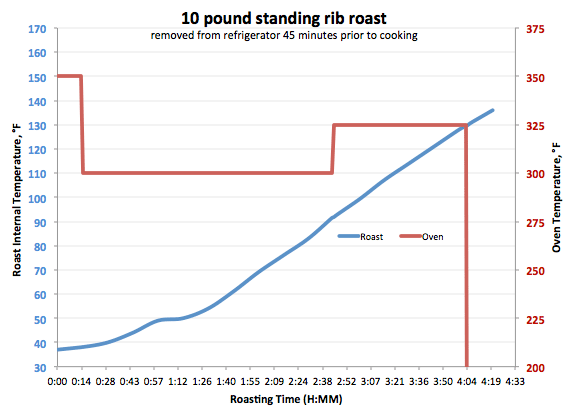Cooking a Roast Beef: Graph of the progress of cooking a big roast.
A few times a year we invite friends or family over and have roast beef and Yorkshire pudding. According to an amusing Yorkshire pudding recipe that I’ve been using (and tweaking) for years,
This is where the clairvoyant comes in to the picture. You can count on the Yorkshire Pudding to be done in 20 minutes. The meat will be done when it wants to be done. If it’s roast beef, it’ll will never be done. Accept it. The thing is, you’ve got to serve the Yorkshire Pudding immediately. It’s at its peak the minute you pull it out, and it diminishes with each second that passes from that point on. Time is of the essence. You can’t let it cook much longer than 20 minutes. You’ve got to hit the timing right. No tips there. Say a prayer to Jane Austin and do your best.
I think the roast tastes best when it has rested for about 10 minutes after coming out of the oven. This means that I need to put the Yorkshire in 10 minutes before I am going to take the roast out of the oven, and I need to get the butter melting 10 minutes before that, and I need to start getting the oven up to temperature 10–15 minutes before that. I need to know when that roast will be done with precision 30 minutes or more ahead of time.
I use this webpage as a guide for how long the roast will take, ballpark, in order to roughly time dinner…but that’s not nearly good enough. Just about every time we cook the roast I take copious measurements (internal meat thermometer) in order to predict when it will be done. Satisfyingly, once the battleship of meat is underway the progress is always linear. Without further ado, I give you the graph of tonight’s deliciousness:

I like to start the oven extra hot (350°) and then drop it 15 minutes in. Almost three hours in I realized that the roast was on target for a slightly late arrival, and I bumped the oven up a little in an attempt to speed things up. Silly me. After 15 years of cooking roasts, you’d think that I would learn. As you can see above, raising the oven by 25° had about zero effect on the roast. Just as aircraft carriers must begin slowing down many miles before docking, so course corrections to the roast need to be made drastically and early.
Indeed, at the end of the graph we find that even taking the roast out of the oven (going from 325°F to 70°F) had no near-term effect on the steady cooking occurring internally as it rested for 15 minutes.
In case you have a 10 pound standing rib roast to cook, the slope of the latter half of that line is almost exactly 2 minutes per degree (0.5° per minute).
Another Data Point: for a 7.5 pound standing rib roast cooking at 300°F, the experimental slope is roughly 1.5 minutes per degree (0.7° per minute). Note that overall cooking time is longer than this, as this slope is the final pace of the meat and does not account for the initial “acceleration” period.
Another Data Point: for an 8 pound standing rib roast starting at 350°F, dropped to 300°F after 15 minutes, the experimental slope started at 1.5 minutes per degree. When I panicked and realized that I had drastically miscalculated and dropped the oven temperature to 250°, and later then 225°, I was able to slow the progress to 2 minutes per degree for the middle hour and eventually even slower, down to 3 minutes per degree. It was still done earlier than I’d hoped but I was able to stretch out an extra 20 minutes of cooking time and an extra 10 minutes of resting time. Final result was 3 hours 15 minutes of cooking, and about 20 minutes resting.
|
Gavin Kistner
05:16PM ET 2012-Mar-05 |
Anyone have any guesses as to why the temperature flatlines at 50 degrees for almost half an hour? My best guess is that moisture in the exterior of the roast hit finally came up to boiling at that point and absorbed some of the heat while the exterior of the roast dried out a little. |